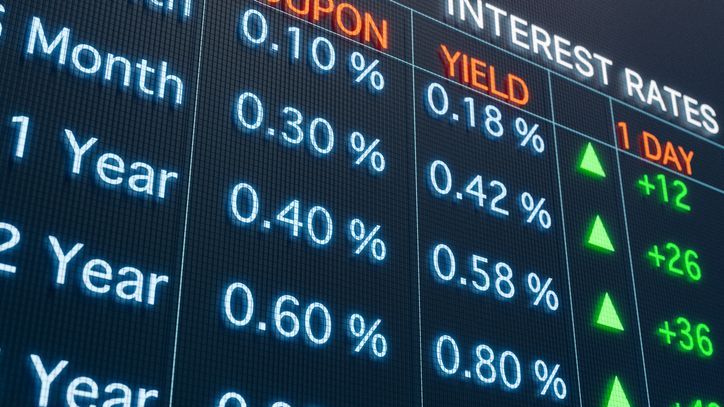Bonds play an important role in a well-diversified investment portfolio, offering a predictable income stream and potential stability to balance the volatility of stocks. These fixed-income securities have an inverse relationship with interest rates. When rates rise, bond prices fall and vice versa. Understanding the mechanics of bonds, the factors influencing interest rates and the impact of interest rate changes on bond prices is essential for making informed investment decisions. A financial advisor can also help you invest in bonds and respond when interest rates change.
Understanding Bonds
Bonds are a type of investment that represents a loan made by an investor to a borrower, typically a corporation or government entity. In essence, bonds are an “IOU” from the issuer to the bondholder, promising to pay back the borrowed funds with interest over a specified period.
When an investor purchases a bond, they are lending money to the issuer in exchange for regular interest payments and the promise of repayment of the bond’s face value, also known as the par value.
The interest paid on this amount is known as the “coupon,” which can be fixed or variable. Bonds come with a maturity date, which could range from a few months to several decades, dictating when the issuer must repay the principal to the bondholders.
Yield is another important term, which represents the return an investor realizes on a bond. For example, a bond with a par value of $3,000, a coupon rate of 5% and a maturity date of 10 years from issuance would pay the bondholder $150 annually for a decade before returning the $3,000 principal upon maturity. To put this into perspective, imagine lending a friend $3,000 with the agreement that they will pay you $150 per year in interest and return the full $3,000 after 10 years.
Alternatively, suppose you buy the bond one year after it was issued and it’s price is $2,500. This bond will still pay you $150 per year because that is the coupon yield. However, since you are receiving $150 on a $2,500 investment the current yield is 6%. If you hold it until maturity your total return, also called yield to maturity, will be 8%.
The bond market has evolved to include a wide variety of issuers and bond types, such as government bonds (e.g., U.S. Treasury bonds), corporate bonds issued by companies, and municipal bonds issued by local governments to fund public projects like infrastructure improvements.
How Rising Interest Rates Affect Bonds

As interest rates climb, the market value of bonds tends to decline. This happens because bonds entering the market now offer higher coupon rates to align with the elevated interest rates, making previously issued bonds with lower coupon rates less attractive to investors.
Investors will naturally gravitate toward the newer bonds that provide a better return on their investment, depressing the value of the older bonds that offer lower returns. So, as an example, if you buy a bond with a 2% coupon rate when prevailing interest rates were 2% and the rates later go up to 3%, your bond value will decline as investors can now buy new bonds with the higher coupon rate.
You should also note that duration plays a central role in a bond’s sensitivity to interest rate changes. In simple terms, duration indicates how much a bond’s price will change when interest rates fluctuate. Longer-duration bonds are typically more sensitive to interest rate adjustments than shorter-duration bonds.
For example, if interest rates rise by 1%, a bond with a duration of 10 years may experience a price decline of 10%, while a bond with a five-year duration may only see a 5% price drop.
How Falling Interest Rates Affect Bonds
When interest rates decline, bonds that were issued earlier with higher coupon rates become more appealing when compared with new bonds being issued.
As an example, let’s say you have a choice between two bonds: Bond A, which was issued last year with a coupon rate of 5%, and Bond B, which is being issued today with a coupon rate of 3%. If you’re an investor looking to maximize your returns, Bond A will be the more appealing option, as it offers a higher coupon rate.
This increased demand for existing bonds with higher coupon rates drives up their prices in the secondary market. However, investors should also consider the potential risks associated with investing in existing bonds during falling interest rate environments, such as the possibility of the issuer defaulting or the bond being called early.
Who Sets Interest Rates?
Before answering this question, you’ll need to understand the difference between short- and long-term interest rates.
Short-Term Interest Rates
Short-term rates apply to financial instruments with maturities of less than one year, such as Treasury bills or commercial paper, and are more sensitive to changes in monetary policy and economic conditions. Long-term rates, on the other hand, apply to financial products with maturities exceeding one year, like mortgages or corporate bonds, and are influenced more by market expectations about future economic growth and inflation.
Central banks, such as the Federal Reserve, play an important role in setting short-term interest rates. They use tools like open market operations, where they buy or sell government securities to influence the money supply and short-term rates. For example, when the Federal Reserve lowers short-term rates, it can lead to lower borrowing costs for consumers, such as reduced interest rates on credit cards and personal loans.
Additionally, central banks set the discount rate, which is the interest rate charged to banks for borrowing from the central bank, and reserve requirements, which determine the amount of money banks must hold in reserve. By adjusting these tools, central banks can effectively control short-term interest rates and influence economic activity.
Long-Term Interest Rates
Long-term interest rates are primarily determined by market forces, such as supply and demand for long-term debt securities, inflation expectation and economic growth projections. When the demand for bonds increases, prices rise and yields fall, leading to lower long-term interest rates. Conversely, when bond supply increases or demand decreases, prices fall and yields rise, resulting in higher long-term rates.
Inflation expectations also play a crucial role, as investors demand higher yields to compensate for the expected loss of purchasing power over time. For example, during the high-inflation period of the late 1970s and early 1980s, long-term interest rates in the United States reached record highs, with the 10-year Treasury yield peaking at over 15% in 1981.
Changes in long-term interest rates have significant implications for the economy and financial markets. When long-term rates rise, borrowing costs increase for businesses and consumers, which can slow down economic growth. Higher rates also lead to lower bond prices, affecting the value of bond portfolios. Conversely, falling long-term rates can stimulate borrowing and economic activity, while boosting bond prices.
Ways to Respond to Rising Rates
Here are four common strategies to consider when responding to rising rates:
- Diversify bond holdings across maturities: By spreading investments across short-, medium-, and long-term bonds, investors can mitigate the overall impact of rising rates on their portfolio.
- Consider shorter-duration bonds: Shorter-duration bonds are typically less sensitive to the interest rate environment, making them a more stable option when rates rise.
- Explore alternative fixed-income: Look into investments such as high-yield bonds, preferred stocks, or floating-rate bonds, which may offer higher yields and be less affected by rising rates.
- Implement a bond ladder: Purchase bonds with staggered maturities, allowing investors to reinvest maturing bonds at potentially higher rates while maintaining a steady income stream.
By carefully evaluating their options and diversifying their portfolios, investors can better position themselves to weather the impact of rising interest rates on their bond investments.
How Interest Rates Affect Stocks vs. Bonds

When the Federal Reserve raises interest rates, bonds aren’t the only financial instruments that feel the effects. Higher interest rates result in increased borrowing costs for companies, potentially impacting their profitability and stock prices. As a result, interest rate increases can lead to more volatility and slower growth in the stock market.
For example, a company that relies heavily on debt financing may see its earnings decrease as interest expenses rise, which could lead to a decline in its stock price. Moreover, rising interest rates can make fixed-income investments more attractive relative to stocks, leading to a shift in investment capital away from equities.
However, the relationship between interest rates and stock prices is complex and influenced by various factors, such as company financials, market sentiment and economic conditions. In contrast, the effect of interest rate changes on bond prices is more direct and predictable.
Bottom Line
Bonds have an inverse relationship with interest rates, with rising rates leading to falling bond prices and vice versa. Investors can navigate changing interest rate environments by diversifying their bond holdings, considering shorter-duration bonds, exploring alternative fixed-income investments and implementing strategies like bond laddering. By staying informed about the factors influencing interest rates and their impact on both stocks and bonds, investors can make strategic decisions that align with their financial goals and risk tolerance, ultimately building a robust and resilient investment portfolio.
Fixed-Income Investing Tips
- Buying individual bonds isn’t the only way to add fixed-income assets to your portfolio. You can also consider investing in bond funds, which pool money from investors and then purchase a basket of bonds and other assets. These mutual funds are a convenient way to add to further diversify your portfolio, especially for investors without the knowledge or desire to buy bonds individually.
- A financial advisor can help you integrate fixed-income instruments into your portfolio. Finding a financial advisor doesn’t have to be hard. SmartAsset’s free tool matches you with up to three vetted financial advisors who serve your area, and you can have a free introductory call with your advisor matches to decide which one you feel is right for you. If you’re ready to find an advisor who can help you achieve your financial goals, get started now.
Photo credit: ©iStock.com/Torsten Asmus, ©iStock.com/cagkansayin, ©iStock.com/standret
